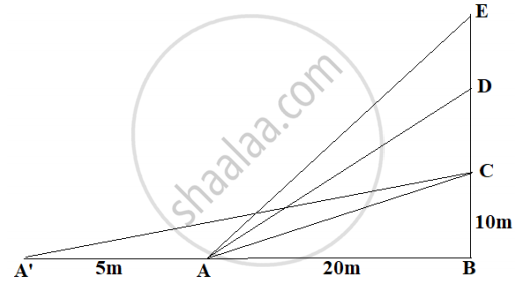Advertisements
Advertisements
प्रश्न
Show that `2tan^-1 {tan alpha/2 * tan(pi/4 - beta/2)} = tan^-1 (sin alpha cos beta)/(cosalpha + sinbeta)`
उत्तर
L.H.S. = `tan^-1 (2tan alpha/2 * tan (pi/4 - beta/2))/(1 - tan^2 alpha/2 tan^2 (pi/4 - beta/2))` ......`("since" 2 tan^-1x = tan^-1 (2x)/(1 - x^2))`
= `tan^-1 (2tan alpha/2 (1 - tan beta/2)/(1 + tan beta/2))/(1 - tan^2 alpha/2 ((1 - tan beta/2)/(1 + tan beta/2))^2)`
= `tan^-1 (2tan alpha/2 (1 - tan^2 beta/2))/((1 + tan beta/2)^2 - tan^2 alpha/2 (1 - tan beta/2)^2)`
= `tan^-1 (2tan alpha/2 (1 - tan^2 beta/2))/((1 + tan^2 beta/2)(1 - tan^2 alpha/2) + 2 beta/2 (1 + tan^2 alpha/2))`
= `tan^-1 ((2tan alpha/2)/(1 + tan^2 alpha/2) - (1 - tan^2 beta/2)/(1 + tan^2 beta/2))/((1 - tan^2 alpha/2)/(1 + tan^2 alpha/2) + (2tan beta/2)/(1 + tan^ beta/2))`
= `tan^-1 ((sin alpha cos beta)/(cos alpha + sin beta))`
= R.H.S.
APPEARS IN
संबंधित प्रश्न
If `sin (sin^(−1)(1/5)+cos^(−1) x)=1`, then find the value of x.
If a line makes angles 90°, 60° and θ with x, y and z-axis respectively, where θ is acute, then find θ.
if `sin(sin^(-1) 1/5 + cos^(-1) x) = 1` then find the value of x
Prove that:
`cos^(-1) 4/5 + cos^(-1) 12/13 = cos^(-1) 33/65`
Prove that:
`cot^(-1) ((sqrt(1+sin x) + sqrt(1-sinx))/(sqrt(1+sin x) - sqrt(1- sinx))) = x/2`, `x in (0, pi/4)`
Prove that `tan {pi/4 + 1/2 cos^(-1) a/b} + tan {pi/4 - 1/2 cos^(-1) a/b} = (2b)/a`
Find the value, if it exists. If not, give the reason for non-existence
`tan^-1(sin(- (5pi)/2))`
Find the value, if it exists. If not, give the reason for non-existence
`sin^-1 [sin 5]`
Find the value of the expression in terms of x, with the help of a reference triangle
`tan(sin^-1(x + 1/2))`
Find the value of `cot[sin^-1 3/5 + sin^-1 4/5]`
Prove that `tan^-1x + tan^-1 (2x)/(1 - x^2) = tan^-1 (3x - x^3)/(1 - 3x^2), |x| < 1/sqrt(3)`
Find the number of solutions of the equation `tan^-1 (x - 1) + tan^-1x + tan^-1(x + 1) = tan^-1(3x)`
Choose the correct alternative:
`tan^-1 (1/4) + tan^-1 (2/9)` is equal to
Choose the correct alternative:
The equation tan–1x – cot–1x = `tan^-1 (1/sqrt(3))` has
Choose the correct alternative:
If `sin^-1x + cot^-1 (1/2) = pi/2`, then x is equal to
Evaluate `cos[cos^-1 ((-sqrt(3))/2) + pi/6]`
The value of cos215° - cos230° + cos245° - cos260° + cos275° is ______.
The value of `"tan"^ -1 (3/4) + "tan"^-1 (1/7)` is ____________.
If `"cot"^-1 (sqrt"cos" alpha) - "tan"^-1 (sqrt"cos" alpha) = "x",` the sinx is equal to ____________.
The value of cot `("cosec"^-1 5/3 + "tan"^-1 2/3)` is ____________.
The domain of the function defind by f(x) `= "sin"^-1 sqrt("x" - 1)` is ____________.
`"cos" (2 "tan"^-1 1/7) - "sin" (4 "sin"^-1 1/3) =` ____________.
The value of `"cos"^-1 ("cos" ((33pi)/5))` is ____________.
If `6"sin"^-1 ("x"^2 - 6"x" + 8.5) = pi,` then x is equal to ____________.
If `3 "sin"^-1 ((2"x")/(1 + "x"^2)) - 4 "cos"^-1 ((1 - "x"^2)/(1 + "x"^2)) + 2 "tan"^-1 ((2"x")/(1 - "x"^2)) = pi/3` then x is equal to ____________.
The Government of India is planning to fix a hoarding board at the face of a building on the road of a busy market for awareness on COVID-19 protocol. Ram, Robert and Rahim are the three engineers who are working on this project. “A” is considered to be a person viewing the hoarding board 20 metres away from the building, standing at the edge of a pathway nearby. Ram, Robert and Rahim suggested to the firm to place the hoarding board at three different locations namely C, D and E. “C” is at the height of 10 metres from the ground level. For viewer A, the angle of elevation of “D” is double the angle of elevation of “C” The angle of elevation of “E” is triple the angle of elevation of “C” for the same viewer. Look at the figure given and based on the above information answer the following:

Measure of ∠CAB = ________.
What is the value of cos (sec–1x + cosec–1x), |x| ≥ 1
If `tan^-1 ((x - 1)/(x + 1)) + tan^-1 ((2x - 1)/(2x + 1)) = tan^-1 (23/36)` = then prove that 24x2 – 23x – 12 = 0
